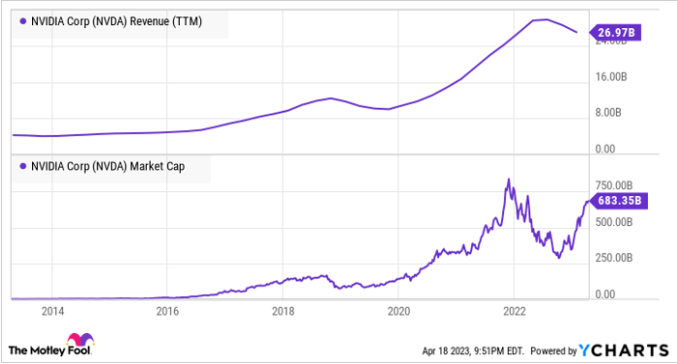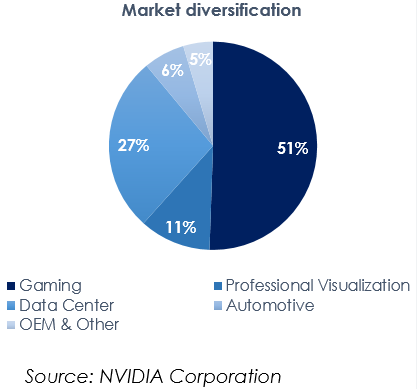Nvidia stock has proven to be a terrific investment over the past decade, turning a modest $100 payout into more than $9,300 over that time period despite volatility along the way.
The chipmaker’s stellar growth can be attributed to the diversification of its graphics cards, which are now deployed in a variety of fields beyond the PCs for which they were originally developed, including data centers, automobiles and artificial intelligence (AI). But can Nvidia stock replicate its stellar gains over the next decade? Let’s find out.
Nvidia’s sales have grown sixfold over the past decade
Nvidia now has a market cap of more than $680 billion, far higher than it was a decade ago. The incredible expansion of the company’s business over the years has driven a substantial increase in its market value.
Nvidia’s fiscal year 2013 revenue was $4.28 billion. In fiscal 2023, the company’s revenue will reach nearly $27 billion. The semiconductor giant’s revenue has multiplied sixfold over the past 10 years, which isn’t surprising given the growing demand for the computing power its graphics cards provide.
From AI, cloud computing, supercomputers, and more, Nvidia’s graphics cards seem to be everywhere. In fact, the company is a dominant player in every segment it operates in. For example, it has an 82% share of the discrete graphics processing unit (GPU) market by 2022. Additionally, Nvidia controls more than 90% of the enterprise GPU market deployed in data centers, supercomputers, and cloud computing.
The company’s dominance in these markets is one reason it can continue to deliver strong returns for investors over the next decade.
Nvidia set for incredible growth over the next 10 years
While weakness in the PC market has hampered Nvidia’s growth in recent quarters, investors would do well to focus on the big picture. Analysts expect a turnaround in the company’s fortunes this fiscal year, with revenue expected to rise 11%. Nvidia expects stronger revenue growth of 24% in fiscal 2025, generating $37 billion.
A closer look at the markets Nvidia operates in shows that it can maintain solid growth for a long time. For example, the global GPU market is expected to expand tenfold over the next decade, generating $400 billion in revenue by 2032, up from $40 billion last year. Nvidia’s fiscal year 2023 (ending Jan. 29, 2023) revenue of $27 billion suggests the company controls more than two-thirds of the segment.
For Nvidia to increase its revenue sixfold to $162 billion over the next decade, it needs to capture around 40% of the global GPU market. However, the company may occupy a larger share of this space in a decade—or even maintain its current position. That’s because Nvidia’s GPUs enjoy a technological advantage over their competitors, which explains why its share of this market has been increasing over the years.
Plus, its GPUs are now powering emerging applications like generative AI, a niche market that presents another huge growth opportunity for the company. Add to that its strong prospects in the automotive, cloud gaming, and server processor markets — all of which are just getting started — and it’s easy to see how rapidly the chipmaker’s revenue could grow over the next decade.
Based on the above discussion, assuming Nvidia has $160 billion in annual revenue 10 years from now and trades at 17 times sales (its five-year average price-to-sales ratio), its market cap could jump to over $2.7 trillion. That would be nearly four times the company’s current market capitalization, suggesting that this tech stock could also continue to make investors richer over the next decade.
Post time: Apr-24-2023


